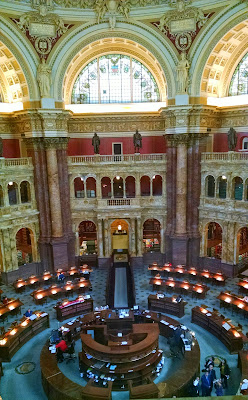I spent a whole day (10 to 5:15) here and did not see it all. Designed of the same beautiful pale yellow stone that is used in most other government buildings in this city, the interior has a long atrium around which the horrible history unfolds, as one starts on the fourth floor and works ones way down. This atrium is glass covered and reminded me of a railroad station -- such an integral part of the Germans' "Final Solution". I have been to such museums in NY, Jerusalem and smaller ones in many other cities but none that were as comprehensive, with a significant slant on US responses before, during and after the war. It showed how gradually Hitler came to power, consolidated his power and set to work first trying to drive the Jews out by making life unbearable and dangerous, then deporting them and finally, exterminating them. One huge wall of etched glass, has the names of the numerous European towns where Jews lived before Hitler, including my father's birthplace, Untergrombach, middle row, right, with my imagined "RR Station" below.
The place was very crowded with lots of high school kids who were very respectful. I was quite moved by the experience. The museum repeatedly discussed the plight of the Roma (gypsies) and other victims. It also had exhibits on the three post-Holocaust genocides: Cambodia's killing fields, the Serbo-Croation conflict and Rwanda. It seems humanity has not learned yet, despite the saying "Never Again! We had lunch in the museum's cafe, located in a small building outside the Memorial.
Our final day was for Congress and the Library of Congress. We had planned to visit the adjacent Supreme Court as well. I had to be admitted to its Bar to oppose a Petition for Certiorari in the late '70's. (Since about 95 to 99 percent of such petitions are denied, winning that one was rather easy.) But our tourism stamina gave out before we got there, which was a shame because Lene has never been there. On our way we passed the Frances Perkins Department of Labor Building.
Ms. Perkins was one of FDR's "brain trust" and the first female Secretary of Labor. She co-taught a seminar in labor history I took at Cornell in about 1964.
In 2008 Congress opened a huge underground entrance, visitors center, "Emancipation Hall," with Museum, gift shops, a large cafeteria and many restrooms to handle the throngs of tourists. We were shown an inspirational movie about how well Congress works, which is somewhat of a joke given today's hyperpartisanship. Leah, our assigned
tour guide was energetic and bright with the kids but the tour did not include either house of the Congress. We easily secured a pass to visit the House, which was in session, but just barely. The person acting as speaker recognized a stream of Representatives who rose to give speeches of up to four minutes. It was mostly women in red suits on the Democratic side and men in blue suits on the other side. Several democrats spoke in favor of refinancing the Highway Trust Fund and opposing yet-another bill to restrict abortion, which the Republicans are addicted to and will undoubtedly pass. The Republicans spoke in favor of the anti-abortion bill and in memory of slain police officers. They all spoke to an almost empty room. The speeches go into the Congressional Record and are fodder for the folks back home. "See how I represented your interests!"
After lunch we visited the Library of Congress through an underground tunnel which avoids having to go through security again. Our first time here.
The entrance hall reminded me of The Hermitage in St. Petersberg, with its staircase, marble, red, statuary and grandeur.
The main reading room is much smaller than the one in NY but more elegant.
A highlight of my stay here was a visit to the Geography and Map division, where I was given access to their collection of nautical charts published by the United States Navy's Hydrographic Office from about 1850 to 1950. The charts are numbered, to about 6500, with some omissions. I have been studying them and cataloging them, as a volunteer in the Map Room of the NY Public Library for about seven years now. They describe the coastlines of the world (excluding the U.S. and the Philippines which are the subject of a similar series of charts published by the Coast Guard. Each branch of the armed forces had its champions in Congress and back in the 19th century they worked out this geographic compromise.) I had a good conversation with the director of the map room who invited me back. Maybe, by land, some day.







No comments:
Post a Comment